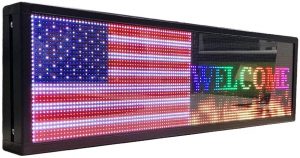LED (light-emitting diodes) sign panels have been around for years. Basically, LCD display matrix of highly sensitive LEDs is arranged in an almost column-row arrangement. A typical sign panel includes more than one LED per square inch. That’s why it’s called a “sign panel,” not a “display panel.”
For many years, a sign panel comprised just a single color LED, although newer technology offers three to four types of color LEDs per display matrix. The higher the number of colors, the brighter the sign and the more expensive it becomes. For example, three-color display costs twice as much as a two-color display and four colors are twice as expensive as three colors. And four-color panels need half the electricity that two-color panels need. So, while three-color panels are more expensive now, they are also more efficient.
 A sign panel consists of a substrate, which is the part of the panel that actually holds the LEDs. In the past, these panels were constructed from either glass or aluminum, but both of those materials are expensive to manufacture and transport. Because LEDs are more energy efficient and are cheaper to make, they are now the most popular choice for signage maker. The substrate is typically made of either acrylic silicon or glass. These materials are all highly reflective and they reflect a lot of light back to the LED chips. This helps the light pass through the substrate and illuminate the pixels inside the display panel. The higher the LED’s count, the higher the reflection and the higher the amount of light that’s reflected.
A sign panel consists of a substrate, which is the part of the panel that actually holds the LEDs. In the past, these panels were constructed from either glass or aluminum, but both of those materials are expensive to manufacture and transport. Because LEDs are more energy efficient and are cheaper to make, they are now the most popular choice for signage maker. The substrate is typically made of either acrylic silicon or glass. These materials are all highly reflective and they reflect a lot of light back to the LED chips. This helps the light pass through the substrate and illuminate the pixels inside the display panel. The higher the LED’s count, the higher the reflection and the higher the amount of light that’s reflected.
In order to light up the pixels in the panel, the light needs to travel through an electrical circuit. When the circuit is designed correctly, the light that’s reflected is able to travel the length of the circuit without bouncing back. The brightness level of the sign is also dependent on the number of LED’s that make up the sign’s matrix, so the panel must be designed to have the right number of chips to adequately illuminate the sign.
Sign panels can be used to create almost any shape, including a circle, an hourglass, an inverted triangle, a circle with a line in the middle, or an oval. Depending on the manufacturer, they can even be customized to fit specific shapes and sizes.
The biggest advantage to using LED sign panels in an indoor setting is the fact that they don’t require a cooling fan. Outdoor signs are generally more susceptible to weather changes, such as the sun or wind. Because the light coming through the sign panel doesn’t have to travel through a fan, you can enjoy a long outdoor sign with a lower energy bill.